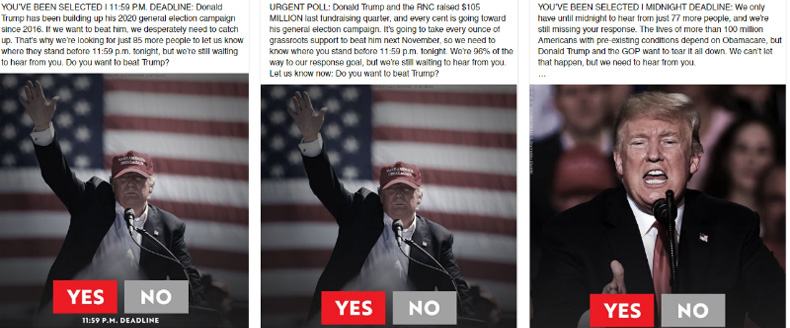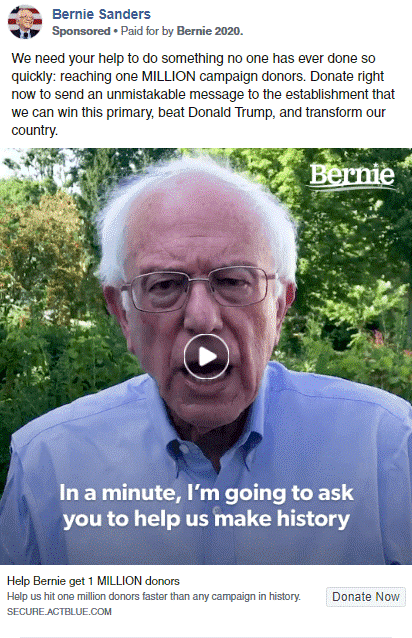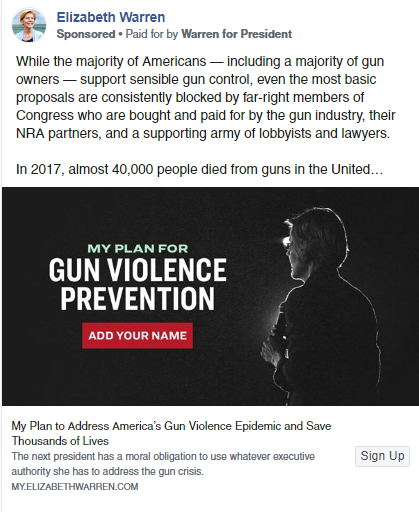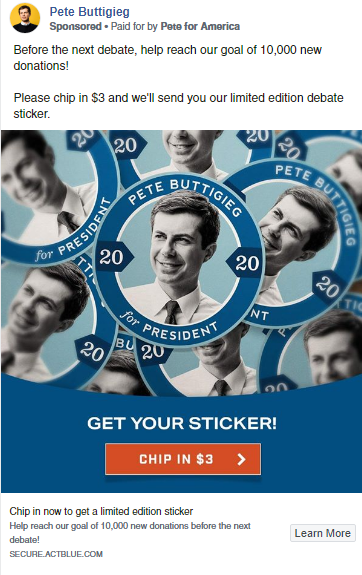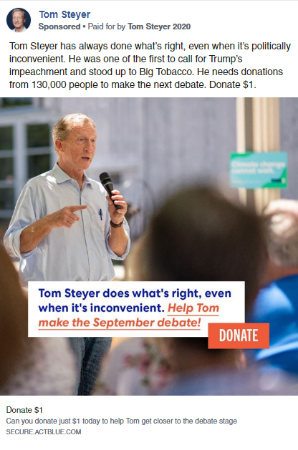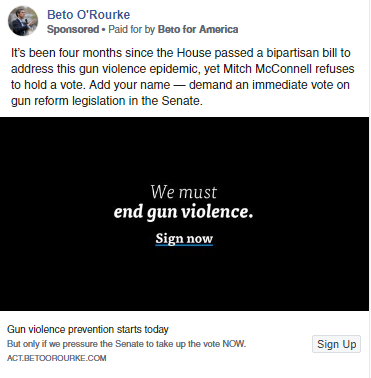New Epolitics.com contributor! Bryan Eastman is a campaign strategist based in North Florida who runs PoliEngine, “a political website builder and communications company that helps candidates get professional-quality communications for a grassroots price.” He recently went through the top presidential campaigns’ Facebook ad spending and prepared the analysis below. Take it away, Bryan:
The 2020 presidential election will be unprecedented in its advertising transparency. This will be the first presidential election in American history where the spending, messaging and design of one of the main campaign communications media (digital advertising) can be scrutinized by anyone in seconds.
In 2018 Facebook rolled out its political ad transparency library in the United States and has now extended it worldwide. Almost every major digital advertising company, including Twitter and Google, followed. Their transparency tools give us a peek behind the curtain to see how the candidates are using paid social media to accelerate their campaigns.
Recently on my PoliEngine blog, I looked at how the candidates were using these channels before the debate, what it says about their campaigns and how candidates can put their best ideas to work online.
For today’s purposes, let’s take a broader look: let’s examine how the candidates are using Facebook this time as a way to gain insight into overall campaign strategy. What they’re asking for and how they’re asking for it in real time gives us incredible insight into the candidates. Here are some of the ways candidates are using Facebook at this early stage of the campaign.
Donald Trump
A lot of ink is spilled talking about Trump’s massive investments in digital marketing. He is outspending almost all of the Democrats, with a much more complex and savvy strategy. Currently the campaign is running 1,200 Facebook ads, with $386,793 spent on the medium in the past week (as I write this piece).
Their main focus, just like most of the Democrats’ ads, is to collect emails and collect small-dollar donations through unique asks. Because Trump is Trump, his digital strategy has a Trumpian edge: tribal culture war politics with intense copy. Reading his Facebook ads is like reading Trump tweets with exclamation points, all-caps and Trump catchphrases sprinkled about.
For instance: With cities across the United States banning plastic straws as a way to reduce single-use plastics, Trump is selling plastic “Trump Straws” — since “Liberal paper straws don’t work!” You can buy 10 custom trump branded straws for the low price of $15.
So while Trump’s overall messaging strategy is controversial, and it remains to be seen if it will turn out voters in 2020, it works great in an online environment where hyperbole and tribalism are powerful forces.
Trump is also using digital tools to reach out to communities in which he’s polling poorly. His “Women for Trump” and “Latinos for Trump” ad campaigns include thousands of separate ads, all being split tested (ed note: A/B tested). They’re designed to get sign-ups from the targeted constituencies, and they include ads focusing on issues that each group may care about, such as border security for women and the economy for Latino voters.
Joe Biden
All the Democrats, Joe Biden included, are running far less sophisticated and well-financed operations than Trump. For example, Uncle Joe has 110 ads being run and $106,037 spent in the last week, with only a few variations being tested. That’s about â…“ of Trump’s overall spend, and a small fraction of the ad variants.
Judging from his ads, Joe is focusing on what polling shows as his strength: the idea that he’s seen as the most electable candidate against Donald Trump. According to a recent Reuters poll, 36% of Democrats say they are simply looking for someone who can win, and among them Biden leads.
He’s leaning into this perceived strength, making beating Trump the centerpiece of his Facebook campaign. Nearly every ad now running shows either a photo of Trump or mentions Trump in the copy, with an ask to fill a survey or chip in money.
Bernie Sanders
Bernie is running a relatively sophisticated Facebook campaign, with 630 ads running and lots of variation testing, spending at the upper level of the Democratic campaigns with $114,111 in the past week. Bernie is focused less on Trump and more on issues, plus throwing shade at the establishment. He wants you to donate not to beat Trump, but to show the establishment that HE can beat Trump.
Bernie seems to be the only candidate not running a lot of survey ads, likely an indication that he has all the email addresses he needs at this point, and now just needs to get those supporters to donate.
Elizabeth Warren
Warren has a plan for that, and her digital marketing is completely focused on getting that message out there. Her ads focus on abolishing the electoral college, canceling student debt, taxing the rich, supporting the green new deal, and more. Each links to a petition on that issue, a clever way to be on-brand while collecting emails for fundraising.
Her ad campaign is relatively sophisticated, testing various policy petitions, copy to go with them, and targeted audiences to whittle things down to the best options. Senator Warren is running 790 Facebook ads with $111,334 spent in the last week.
Kamala Harris
Sen. Harris is super-focused on list-building at this point, primarily via a simple “what issues do you care about” survey (admittedly a tactic just about every candidate is using).
More interesting is her rapid response game. Following the shootings in El Paso and Dayton, her campaign posted hundreds of ads asking voters to sign a petition to fight against gun violence. All of these ads were shut down within 24 hours. Whether the ads didn’t test well, started to lose their luster, or were seen as profiting off of tragedy we can’t be sure, but it was certainly a fast-moving reaction to national news.
Kamala seems to be particularly proud of her debate performance, spending thousands to get highlight videos out to voters. Her visuals go back and forth between portraying her tough and showing her as approachable, a contrast also visible on her other digital media channels including her website.
Pete Buttigieg
Pete Buttigieg comes across the nice guy in the race who may be smarter than you but is down-to-earth about it.This folksy charm has catapulted him to a leader of a crowded field of very good politicians, and his digital ads try to cement that impression.
Buttigieg spent the most among the Democrats in the field, with 710 ads and $203,412 spent in the past week. The only ones rivaling him are Trump and Tom Steyer.
Already officially qualified for the September debates, his main focus, like a lot of these down-ballot candidates, is to collect emails, but he does so in an inviting way that few other candidates replicate.
Tom Steyer
Tom Steyer is blowing out the field, spending $1,199,871 on Facebook ads in the past week, with over 600 ads running. Steyer just jumped into the race recently and is employing a spaghetti-at-the-wall strategy to figure out what ads will convert best. The content is all over the place: asking for small donations, making personal asks via video, giving away campaign swag, etc.
He’s focused on getting to 130,000 individuals donations before the September deadline (ed note: he managed to buy his way in) and is willing to go all-out to get there. Not particularly well known outside of political junkie circles, he’s walking a difficult line, needing to introduce himself to the electorate while begging them for a donation. A billionaire himself, he doesn’t really need your money: he needs individual donors and is asking for a very modest contribution of $1. Taking credit-card fees into account, a $1 donation is essentially a wash, but each one helps him meet the September debate requirement.
Beto O’Rourke
What is Beto up to? He’s spending less than any of the other well-known campaigns by a significant fraction: in the past week a measly, $36,459 on Facebook (12k the week before) and has been averaging about 5k/week on Google ads.
This trend comes at a particularly bad time, as Beto’s made the donation level to reach the September debates but is polling too low, with numbers still sliding. Perhaps he’s looking at calming his high burn rate after a lackluster quarter, or his campaign believes Facebook isn’t a good vehicle for raising those poll numbers. Still, he’s so close to qualifying for the debates that it’s odd he’d pull back now.
As you’d guess, he’s less focused on small donors as a result and more on issues that will endear him to voters. Since the shooting in El Paso, he’s been solely focused on connecting with the electorate, capitalizing off of national news happening in his backyard.
Is his drop in spending a sign that his campaign is on its last legs or just focusing limited funds in better ways? We can’t be sure, but Beto needs all the juice he can get right now, and he doesn’t appear to be working to replenish it online.
Andrew Yang
Yang’s campaign is powered by internet energy. His message of focusing on math, universal basic income, and his non-traditional tech background are red meat online, where supporters have created a real culture around his campaign similar to those Sanders and Trump supporters built in 2016.
However, Yang’s ad spending is pretty unremarkable. He spent $52,910 last week and $1,188,130 total, with only 25 ads running now. It’s a pretty unsophisticated digital strategy, with minimal microtargeting and split-testing, which is surprising for a digital-powered candidate. Perhaps he’s focusing on other media, feeling like he needs to get his name I.D. up among less digitally inclined people. We can’t be sure, but we can surely suggest that his Facebook strength could use some boosting (ed note: pun added and fully intended).
Andrew Yang is aware of the unawareness voters have of him: most of his ads introduce him to voters, or using mocks of legitimate breaking news designs to make people click through. It’s an interesting strategy, and we’ll see how it helps him in the polls.
Conclusion
These new transparency libraries offer a huge range of insights into campaign priorities and strategies, though for today’s purposes, we mainly focused on one channel at a high level. Will the mainstream media realize the unprecedented level of access they now have?
Bryan Eastman is a campaign strategist based in North Florida and runs PoliEngine, a political website builder and communications company that helps candidates get professional-quality communications for a grassroots price.

